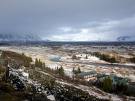Naddodd
was a Norwegian who was sailing from Norway to the Faroe Islands
in the ninth century. He and his men lost their way and found a new land much farther towards the northwest. They had
come to the east coast of Iceland. They explored the surroundings but found no signs of human habitation and soon turned back.
When they were sailing away, some snow fell on the mountains and Naddodd decided to give this new land a name, 'Snaeland'
(Snowland).
Gardar
Svavarsson, a Swedish man, was the next Viking to sail to Iceland.
He wanted to know more about the country and sailed around it and found out that it was a big island. During the winter he
stayed with his men in the northern part of the country. They had to build some houses there to live in and ever since
the place has been called 'Husavik' (House Bay) an there is a village there now. The next summer Gardar finished his trip
around the island and sailed away. He gave the island a new name, named it after himself and called it 'Gardarsholmi' (Gardar's
Island).
Floki
Vilgerdarson, later nicknamed Raven-Floki, was a Norwegian
Viking who set out to seek this new land. He took with him his family, friends and household and wanted to settle down in
'Gardarsholmi'. On his ship he also had three ravens and whenever he thought he was near land he released the ravens one by
one so that they could show him the right way. The ravens always came back to the ship but one day the third raven flew
forwards. Floki followed that raven and found the new land. Floki and his men settled in a fjord on the northwest part of
the island. They vere busy all summer building, fishing, gathering eggs and having fun but forgot to make any hay for the
winter.
The
following winter all their animals died of cold and hunger. Next spring Floki walked up to a top of a mountain and saw a fjord
full of ice on the other side. He called the fjord 'Isafjordur' (Icefjord) and gave the country a new name 'Island' (Iceland),
which it has carried ever since. Floki went back to Norway a few years later, he was very bitter and talked badly of the new
country but one of his crew said the country was wonderful and full of goods.
The North Atlantic islands seem to have been of only passing concern to the centers of power
in Europe, so very little historic documentation exists about their settlement. One early 9th century Latin text describes
North Atlantic islands that may be the Faeroes and perhaps Iceland. Thankfully, two Icelandic documents detail the early settlement
of Iceland. One, the Book of the Icelanders, was written between A.D. 1122 and 1133 while the Book of Settlements
might have been written in the 12th century, but is only attested to from the 13th century. In all of these documents, it
is apparent that the Vikings were not alone in their interest in these islands, and that early settlers came from the British
Isles as well, and some attribute the discovery and settlement of the Faeroes and Iceland to the Celts.

